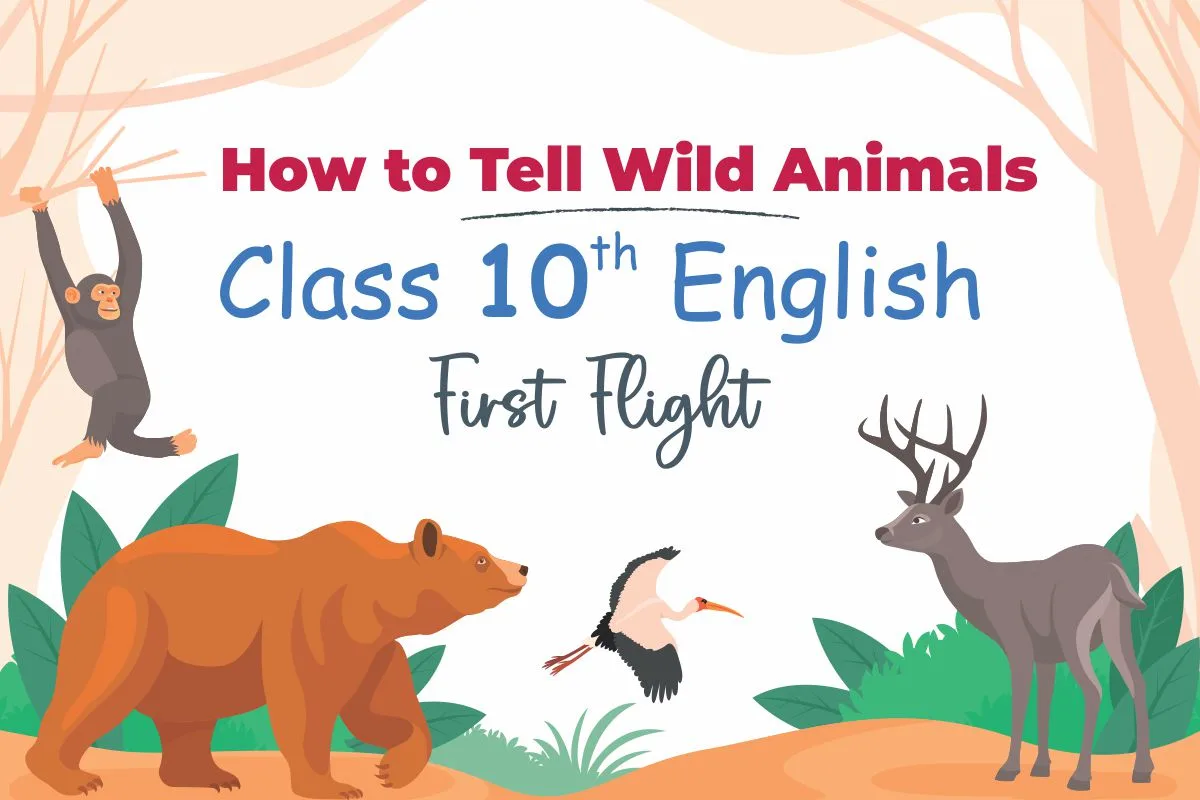Chapter 3 of the CBSE Class 10 English Book, ‘First Flight’, has two poems. The first one is called How to Tell Wild Animals and is written by Carolyn Wells. Here’s a simple summary of the poem – How to Tell Wild Animals.
Link: https://www.youtube.com/watch?v=7VbIj9s2lQE
CBSE Class 10 English How to Tell Wild Animals Summary
“How to Tell Wild Animals” is a humorous poem penned by Carolyn Wells. The poem proposes potentially threatening ways for identifying wild animals. The poem feels like solving a playful puzzle to identify the names of the animals. This poem consists of six stanzas, with each stanza dedicated to describing a wild animal based on its unique characteristics and features. It’s an engaging and hilarious poem.
How to Tell Wild Animals Poem Explanation
We’ve also included the poem below to make it easier for students to understand. This way, they can read the poem and its meaning together.
If ever you should go by chance
To jungles in the east;
And if there should to you advance
A large and tawny beast,
If he roars at you as you’re dyin’
You’ll know it is the Asian Lion…
Or if some time when roaming round,
A noble wild beast greets you,
With black stripes on a yellow ground,
Just notice if he eats you.
This simple rule may help you learn
The Bengal Tiger to discern.
If strolling forth, a beast you view,
Whose hide with spots is peppered,
As soon as he has lept on you,
You’ll know it is the Leopard.
’Twill do no good to roar with pain,
He’ll only lep and lep again.
If when you’re walking round your yard
You meet a creature there,
Who hugs you very, very hard,
Be sure it is a Bear.
If you have any doubts, I guess
He’ll give you just one more caress.
Though to distinguish beasts of prey
A novice might nonplus,
The Crocodile you always may
Tell from the Hyena thus:
Hyenas come with merry smiles;
But if they weep they’re Crocodiles.
The true Chameleon is small,
A lizard sort of thing;
He hasn’t any ears at all,
And not a single wing.
If there is nothing on the tree,
’Tis the chameleon you see.
Explanation:
The poet gives a description of various wild animals. In the first stanza, the poet wonders how the readers would recognize various animals in the jungle. Then, the poet starts to describes the Asian Lion. She says if you encounter an animal with yellowish-brown fur roaring so fiercely that you’re scared to death, it means you’ve met an Asian Lion.
In the second stanza, the poet describes a supreme and ruling animal with black stripes on its yellowish skin, wandering freely through the jungle. She explains that if it begins to eat you, you’ll know for sure it’s a Bengal Tiger. But it’s not much use recognizing it if it means you have to end up as its meal.
In the third stanza, the poet talks about an animal who walks at a slow pace with small spots covering its body, resembling a salt-and-pepper pattern. These spots seem like they were made by someone hitting the animal with tiny objects. If that animal jumps on you, you’ll realize it’s a Leopard. Even if you cry, the leopard won’t leave you easily. So, it’s important to be alert and prevent it from jumping onto you.
In the fourth stanza, the poet mentions encountering an animal in a field that hugs you tightly, then surely that it is a Bear. If you’re still doubtful, another hug from the animal will confirm it. The poet highlights that when someone loves and cares for you, they express it through tight hugs. However, if a bear hugs you in reality, it means danger, as its tight embrace can be deadly.
In the fifth stanza, the poet wonders and asks the readers if they know how to identify animals while they hunt their prey. The poet explains that when hyenas catch their prey, they appear to smile. Likewise, crocodiles seem to shed tears as they consume their prey.
In the final stanza, the poet talks about a small reptile capable of changing its skin color. Resembling a lizard, but it does not ears or wings. In the final stanza, the poet talks about a small reptile capable of changing its skin color. Resembling a lizard, it lacks ears or wings. Chameleon’s remarkable skill of changing its skin colour serves as a defense mechanism against hunters and other animals.
We hope and hope that this summary of the CBSE Class 10 English First Flight Poem “How to Tell Wild Animals” has provided you with a quick grasp of the poem. Stay connected with GK Publications for the latest updates on CBSE and study materials. Explore sample papers and question papers from various years to enhance your preparation for the Board exams.








